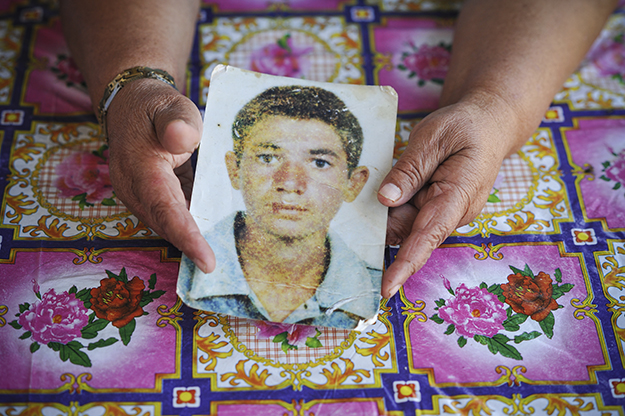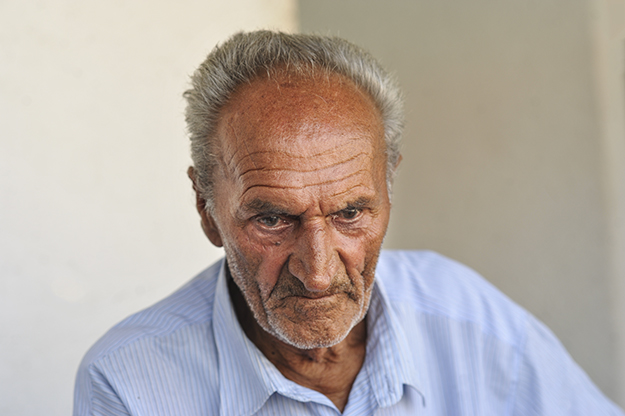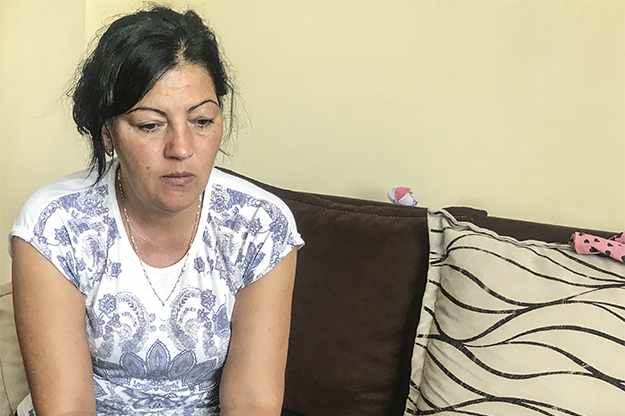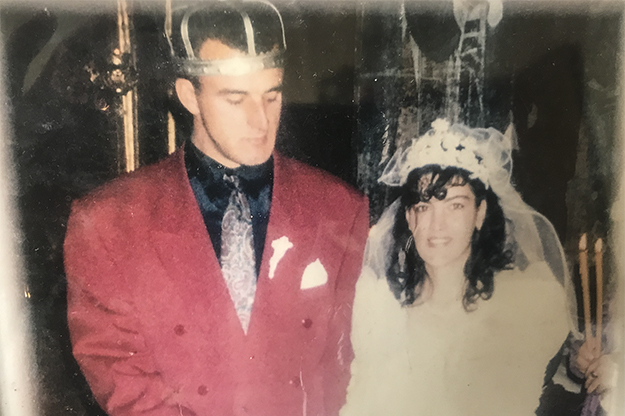Xufe Berisha remembers a hot afternoon on June 18, 1999, the last time she saw the back of her two sons as they walked down the forest to drink water from the river with two of their neighbors.
Like much of the population had been during the NATO air campaign against Yugoslavia, the family from the village of Bec, near Gjakova, were hiding in the mountains. On that day, they were in the village of Raushiq, near Peja.
Xufe, 69, says that she still hears the shouts and echoes of guns in her ears, after which she never saw her sons return.
“We had run out of food two days earlier. In that part in Raushiq, we were in a zone between Serb forces and Kosovo Liberation Army (KLA) members. My sons said they were going out to drink water. A few minutes later, we heard shouts and four shots,” she tells K2.0 in her house in Gjakova.
It was seven days after NATO troops had been deployed in Kosovo following 78 days of bombing from the air. But the Berisha family were still hiding in mountains, afraid and confused, not knowing that the war was over.
Xufe and her husband Agush tried to seek out the place their sons had gone. “They were late. We tried to search in the darkness, but we didn’t see anything,” she says. “We were not sure if the shots we’d heard had killed them. If so, they were each executed with a single bullet.”
The next morning, having spent the night hiding in the forest, they decided to continue to walk toward Montenegro. “We were waiting for our sons, but they never returned,” their father Agush Berisha, now 74, says. “Then we came back, and started searching in every mass grave.”
Hungry while seeking missing children
Xufe and Agush’s sons, Rifat Berisha, 22, and Fehmi Berisha, 18, together with their two neighbors, Vehbi Maliqi, 21, and Xhevdet Cufa, 20, all Egyptians, are among the 1,658 people still missing from the war in Kosovo. Although often overlooked by the mainstream discourse, 461 of those still missing are members of ethnic minorities: Serbs, Roma, Bosniaks, Ashkali and Egyptians.

Xufe and Agush Berisha only have a photo of one of their missing sons. Rifat was aged 22 when he went missing along with his 18-year-old brother, Fehmi, in June 1999. Photo: Atdhe Mulla / K2.0.
According to data from the Humanitarian Law Center (HLC), more than 13,500 people were killed or disappeared in the war in Kosovo, including 10,812 Albanians, 2,197 Serbs and 526 members of other ethnic communities. Of these, more than 1,300 were victims after NATO forces had entered Kosovo in June 1999, ending Slobodan Milošević’s regime in Kosovo and leading to the demilitarization of the KLA.
During this period in the immediate aftermath of the war, in a chaotic security situation as the UN Mission in Kosovo (UNMIK) was deploying, Kosovo became prey to uncontrollable armed gangs that committed crimes with impunity. Ethnic minorities were particularly targeted as violence continued between — and within — ethnic groups.
Members of minority groups in Kosovo were regularly detained, beaten or killed — 715 Serbs and 273 members of other minority communities were killed or are missing from this period.
While attacks on Serbs were based on a sense of vengeance, members of other minorities — who had already found themselves targeted by both sides as they were caught in the middle during the war — were often attacked on suspicion of having been Serb collaborators. During the war, Serbian forces had often forced Roma to bury the bodies of Albanians.
Amnesty International say that by the end of August 1999, more than 230,000 Serbs and other minorities had left Kosovo, with many of those remaining moving to northern municipalities or mono-ethnic enclaves within Kosovo.
Clint Williamson, head of the EU’s Special Investigative Task Force, which was mandated to investigate allegations — initially raised by a Council of Europe report — of crimes committed after the war, said in 2014 that certain elements of the KLA had been involved in violence and threats against ethnic minorities and Kosovar Albanian political opponents.
“These individuals bear responsibility for a campaign of persecution that was directed against the ethnic Serb, Roma, and other minority populations of Kosovo,” Williamson told a press conference in Brussels.
Head of the Humanitarian Law Center in Kosovo, Bekim Blakaj, says that, marginalized and still fearing stigmatization, “most in the non-Albanian communities still don’t have the space to talk openly about their experiences of violence.”
Each year in Kosovo, two days in particular are marked in regard to missing people: the International Day of Disappeared on August 30, and the national Day of Missing Persons on April 27, when families of missing persons come together in protest, trying to put pressure on institutions to actively seek information about the fate of their loved ones.
However, different communities do not all protest together, as Serb families in particular tend to hold separate events. In 2011 the Youth Initiative for Human Rights made a wall in downtown Prishtina with the names of all missing people in Kosovo, which led to objections from some of the Albanian families of missing people.

Agush Berisha, aged 74, has spent years looking for his two missing sons, Rifat and Fehmi, often on an empty stomach due to the family’s severely limited income. Photo: Atdhe Mulla / K2.0.
Sitting on the balcony of his house on the International Day of the Disappeared this year, Agush Berisha tells K2.0 that for 12 years he searched in graves for his sons hoping that he would find them. “At home we didn’t have food because all we had I had to spend on travel searching for our sons,” he says. “There is nothing worse for a father than searching for his children whilst hungry.”
Xufe is deeply regretful she couldn’t see their faces and ask them for apology. “I would like to see them once more, hug them and say to them, ‘Please forgive us — we couldn’t raise you like you deserved,’” she says.
Xufe says that until the war erupted in Kosovo, her two sons had been working for an Albanian family in a village near Gjakova. “The food they gave them to eat for lunch they usually shared with us,” she recalls. “A piece of cheese they took there — they would bring it home.”

Xufe Berisha, aged 69, has lost hope that she will ever find out what happened to her sons, who have now been missing for almost 20 years. Photo: Atdhe Mulla / K2.0.
The couple, who live in deep poverty in a neighborhood in the middle of a garbage dump, has lost the hope they can find the truth about the fate of their children. They have also lost hope of seeing justice. “We are getting older and don’t believe we will live long enough to learn about what happened to them,” Xufe says.
‘Living with alive and dead people at the same time’
In the town of Gračanica, in central Kosovo, Silvana Marinković also still agonizes over whether June 19, 1999, when her husband Dragan disappeared, was the last day of his life.
Dragan Marinković, then 26, was traveling with a truck from his home in Gračanica to Gjilan, together with his two neighbors.
Silvana and her two daughters, the youngest only six months old, had waited two days for his return. Then she went to a British NATO patrol, which had recently entered the area. But no one could tell her anything about her husband or the others.
“It’s hard to live for 19 years searching and searching,” she tells K2.0. “It’s like you are living with an alive and a dead person at the same time.”
Silvana says that life will be particularly hard for the children of that time, like her youngest daughter, who never knew her father. “This is the generation of children born in conflict that will bear the burden of ethnic divisions left on their shoulders without any fault of their own,” she says.

Silvana Marinković believes that the issue of Kosovo’s missing people should be at the top of the political agenda. Her husband, Dragan, has been missing since June 1999. Photo: Serbeze Haxhiaj / K2.0.
Silvana leads a local association of missing persons for the central Kosovo region, which has counted 63 Serb families who are still waiting to hear the fate of their loved ones, and believes that Kosovo’s government in particular should be doing more to help shed light on the fate of missing persons.
She says that missing persons are currently being used as a political device in the verbal clashes between Kosovo’s and Serbia’s authorities that surround the EU-facilitated dialogue in Brussels between the two countries that has been ongoing since 2011. “While they are talking about exchanging territories, I think it is high time they do something far more important — find missing people,” she says. “Justice should also be served.”
Missing people in 2,000 Prosecution files
HLC’s Blakaj agrees that the issues of missing persons has been neglected by politicians and should be amongst the topics on the table in the Brussels dialogue process.
“Until now, we haven’t seen any political will to solve this issue,” he told K2.0. “If this issue were to be included in the dialogue, we would recommend both sides to treat the problem of missing persons as humanitarian, not as politics.”
Blakaj believes that one important step that can be taken to help the families of missing people is for Kosovo’s authorities to create a strategy on how to find more information about possible individual graves or mass graves. “There is no excuse for failures in finding missing people,” Blakaj said. “If there was more commitment, there would be results.”
Prenk Gjetaj, chairperson of the Kosovo Government Commission on Missing Persons, agrees that the issue of the disappeared should be on the table in the dialogue between Kosovo and Serbia’s leaders.
“A lot of time is spent without many results. I think that both parties can do much more to give an answer to families who are waiting to know the fate of their loved ones,” Gjetaj told K2.0.
Adding to the voices of those that believe the issue should be discussed between Kosovo’s and Serbia’s leadership in the Brussels dialogue is The International Committee of the Red Cross (ICRC), which has long been involved in the issue of missing peoples by facilitating communication and work between the two sides. Since 2004, it has chaired an official mechanism set up by the UN referred to as the Working Group on Missing Persons.
“ICRC recommends that the current mechanism of the Working Group should not be duplicated. The issue of missing persons should remain exclusively humanitarian,” Agim Gashi, head of the ICRC mission in Kosovo, told K2.0.
“If the issue of missing persons were to be among the topics in the dialogue, it would provide political support as well as additional pressure on the parties to provide information,” Gashi added.
After the war, 6,044 people were registered as missing, 1,000 of them from non-Albanian communities, although these numbers came down in the years that followed as mass-graves were discovered and bodies identified.
Support in identifying missing people has been provided by the International Commission for Missing Persons (ICMP), an intergovernmental organization based in The Hague. Since it started to help Kosovo through DNA-based identifications in 2003, ICMP has issued DNA identification reports to Serbia and Kosovo for 2,466 missing persons.
In the last five years, despite investigations and excavations — which have increasingly been focused in the south west of Serbia — the trend of finding and identifying missing people has decreased significantly, meaning the families of missing people are being made to wait, seemingly endlessly.
Over the past 19 years since the war, local courts in Kosovo have not found anyone guilty for killing or disappearing people from ethnic minority communities.
Responsibility for such cases initially fell to UNMIK, before transferring to the EU Rule of Law Mission (EULEX) when Kosovo declared independence in 2008, and has recently been handed over to local institutions.
In its final report in 2017, the UN Human Rights Advisory Panel (HRAP) found that “the investigation of enforced disappearances and missing persons carried out by UNMIK failed to meet the minimum standard of an effective investigation as required by international and European human rights standards.”
When EULEX’s mandate for handling war crimes cases came to an end in mid-June this year, around 2,000 files relating to potential perpetrators responsible for missing persons were handed over to Kosovo’s authorities. However, prosecutors have complained that their capacity to handle so many cases is severely limited, evidence has faded and that effective investigation and prosecution requires establishing an effective working relationship with Belgrade.
Blakaj says that state archives held in Serbia must be open in order to provide information regarding individual or mass graves. “If the Kosovo side does not have such archives, then it should start a detailed investigation in order to know the fate of missing persons during and after the war in Kosovo,” he said.
Xufe Berisha doesn’t know who can help in finding information her sons and if those who may have any information are in Kosovo or in Serbia. “Several times, we planned to prepare their graves and made them ready,” she says. “But I have a feeling I will never find them.”

Nearly two decades after her husband Dragan went missing, Silvana Marinković believes there are people who can still shed light on what happened to him. Photo: Serbeze Haxhiaj / K2.0.
Silvana Marinković, on the other hand, who believes that her husband was abducted by Kosovar Albanians in the wave of revenge-attacks shortly after the war, still has a sense of hope, and is adamant that someone must know what happened to him.
“My husband and others were abducted while they were traveling by truck. Neither them nor the truck were ever found,” she says. “This means that there are several people who have done this. There are many who know.”K
Edited by Jack Butcher.
Feature image: Atdhe Mulla / K2.0.

Back to monograph







